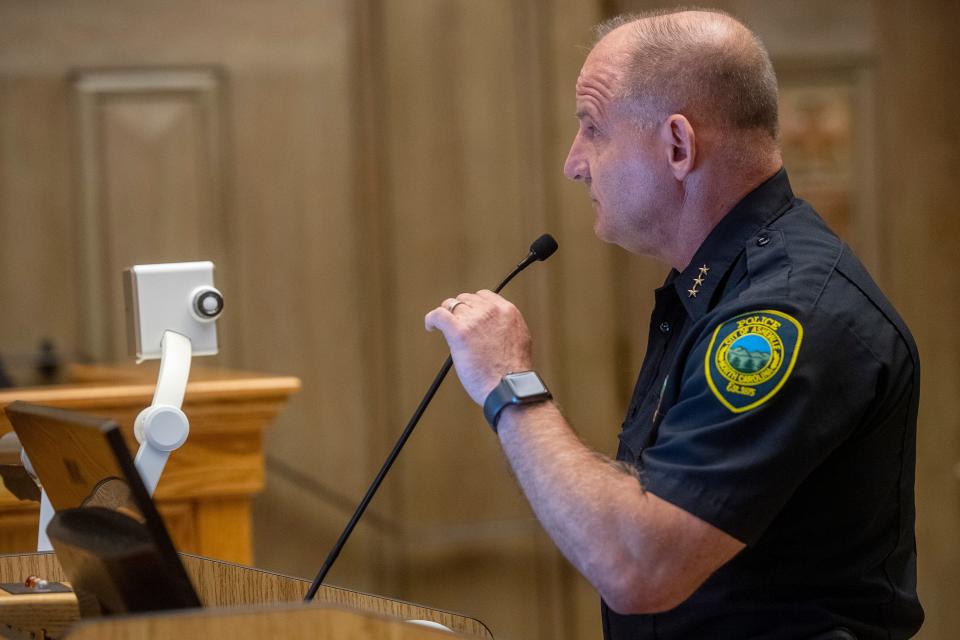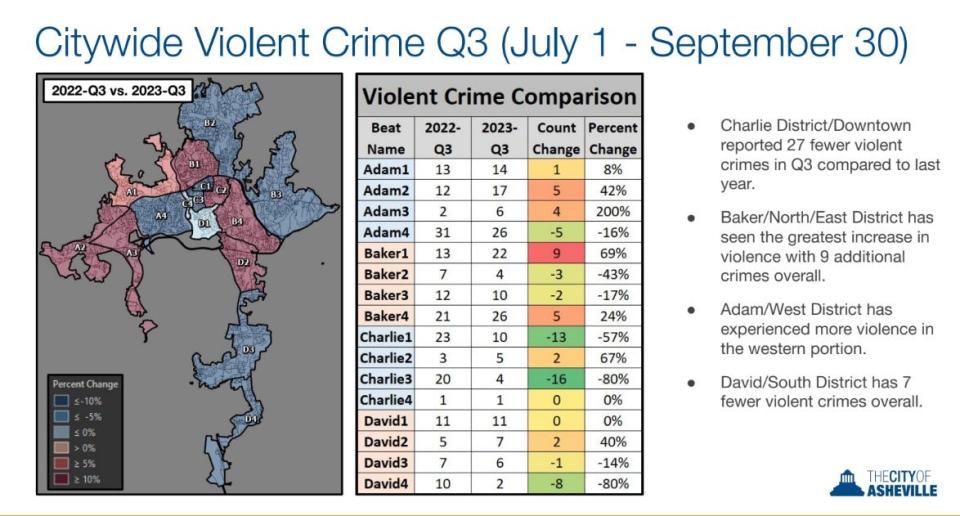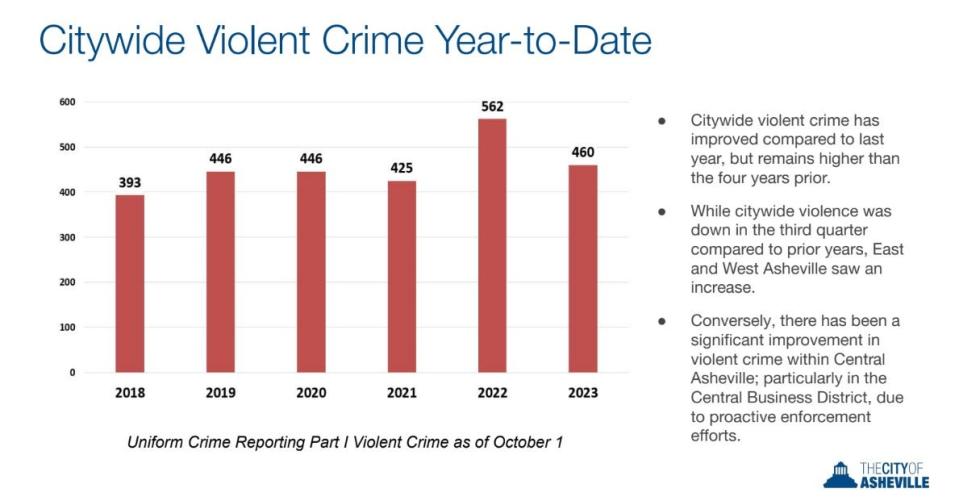Downtown crime dips: APD targeted operations, police presence, $2 million in overtime
ASHEVILLE - Over the past two weeks, the Asheville Police Department has released updated crime numbers for 2023 and announced new “targeted special operations” informed by APD’s data analytics team, which led to 62 recent arrests and citations.
Of the individuals cited or arrested, over half listed A-Hope Day Center as their permanent address, according to court records, leading some to question APD’s priorities.
“I’m just really concerned that the police department is making it a priority to do these lower-level citations that have included panhandling, second-degree trespass, drug paraphernalia,” Densen Gelfand said in the public comment section of an Oct. 24 Environment and Safety Committee meeting. “What’s going to happen when these people are brought into the criminal justice system? … We need to be supporting these people, not citing these people.”
When a similar concern was raised by council member Kim Roney at City Council Oct. 10, saying it puts staff in a “terrible situation” while upcoming homelessness solutions are “not yet available,” Chief David Zack grabbed the microphone and said, “If they are breaking the law and consistently breaking the law, they’ll be arrested.”

“Our officers have shown, repeatedly, discretion at every instance,” Zack continued. “But at some point, when discretion no longer works, we will use all the tools in the tool belt, which includes making arrests.”
More: Some of Asheville's $2.7 million in opioid funds proposed for Fire Department program
What will these 'targeted operations' focus on?
Regarding how APD has shifted its use of staff in the past two years to address crime while staffing levels remain 42% down as of Oct. 3, both spokesperson Samantha Booth and Deputy Chief Mike Lamb mentioned the “various targeted operations” to the Citizen Times. When asked what types of crimes or locations these operations will focus on, Lamb said “It depends on the data.”
“We work closely with our crime analyst team, using a computer statistics model,” Lamb told the Citizen Times. “We meet on a monthly basis at least to look at crime trends, and also specific crimes and who are committing those crimes.”
Lamb said that the Community Engagement, Control Division, Detectives Division and the Criminal Investigations Division work with APD crime analysts to see who the “prolific repeat offenders are.”
“And we find that a lot of these repeat offenders are committing the vast majority of crime,” Lamb added. “We’ve shifted our focus over this last probably six to seven months to address and look at these repeat offenders and be able to hold them accountable for the disproportionate number of crimes that they're committing.”
Regarding the 62 arrests and citations, most of which were for trespassing, Lamb said “That’s one of the big community complaints we’ve been getting over the last couple of months.”
When asked about concerns from members of the community regarding how recent operations led to 32 arrests of Asheville’s homeless population, Lamb said, “We are not trying to criminalize homelessness, but what we are trying to do is address criminal activity.”
“We heard it resonate from the downtown business owners and employees about how there’s folks that are experiencing homelessness, and … they need to be able to have resources to combat their addiction and get back to a state where their mental health is stabilized,” Lamb told the Citizen Times. “But then there’s a group of folks that are unhoused, that commit crimes.”
But as far as how often these operations will occur, what areas will be encompassed, and what crimes will be targeted, the deputy chief said that’s all dependent on what APD data indicates.
What's the cost of officers working more overtime?
In the special operations, officers from “nearly every division in the department” were working outside their normal shifts, an APD news release said.
APD’s downtown presence, spurred by the Downtown Safety Initiative, has also been covered through increased officer overtime. Deputy Chief Jackie Stepp told City Council Oct. 10 that overtime for officers downtown increased by 10% in July, 20% in August, and 13% in September.
Over 27 days in September, Booth said APD officers worked a total of 4,355.5 hours of overtime, totaling $234,434.70 of overtime paid. That’s roughly $8,683 per day.
In comparison, for a period of 77 days at the beginning of 2022, sworn APD officers worked 7,972.67 overtime hours for a total of $390,707.94 overtime paid, roughly $5,074 per day.
In the pay period running from Dec. 24, 2022, to Oct. 13, 2023, APD officers worked a total of 40,167.83 overtime hours, totaling $2,060,369.31 overtime paid, Booth told the Citizen Times Oct. 25.
The last full-year data currently available for officer overtime is from 2021, when sworn officers were paid a total of $813,842.38 in overtime.
More: Asheville Police names Henderson County native as first female deputy chief
Is downtown a crime hotspot? How is increased police presence affecting crime numbers?
When downtown saw a spike in both violent and property crimes during the Downtown Safety Initiative, Lamb attributed this to more officers being in the area and spotting crime as it was occurring. He told the Citizen Times, “If those officers weren’t there, those reports and those arrests would not have been made.”
Downtown has been referenced as a “crime hotspot” by APD, with Stepp telling City Council Oct. 10 that 10% of all city crime happens downtown.
However, data presented by Lamb at the Environment and Safety Committee meeting Oct. 24 indicates that recently, violent crime is happening less often downtown than other places around Asheville. From July 1 through Sept. 30, Asheville’s Central District saw 20 instances of violent crime, while the West Districts had 63 reports of violent crime, the Northeast Districts had 62, and South Asheville had 26.

More: Sheriff gives 2023 Buncombe County crime data, eyes making co-responder program permanent
Violent crime in the Central Business District is down 21% through Oct. 1 of this year compared to last year, and property crime is down 8% in the same period, according to Stepp’s presentation at council. Now that crime has tapered off in the Central Business District, APD attributes this to "increased enforcement downtown,” Stepp told City Council Oct. 10.
How can police presence contribute to both spikes in crime and decreased crime? Lamb says it’s about context and timing.
“If you increase police presence in an area that had less police presence, especially in a crime hotspot, there’s going to be reports and arrests made; but then with consistent police presence over time, that levels off because it sets expectations on behavior within a certain geographic area,” Lamb told the Citizen Times.
Lamb also mentioned how there are a lot of factors that cause crime rates to fluctuate within a certain municipality, but this year’s pattern seems to be different than years past.
“Usually in normal patterns, crime spikes when it gets warmer, there’s people visiting from the summer, so it spikes in July, but it actually went down then and spiked in the spring of this year,” Lamb told the Citizen Times.
In the Environment and Safety meeting Oct. 24, council member Sheneika Smith said to Lamb: “Asheville has a track record of responding to the loudest and who is more persistent. It does not mean that you are the most impacted. … So, my question is, as we’re coordinating a lot of our responses or a lot of our resources to focus on downtown, what are we doing for other geographic areas that kind of need that proactive approach as well?”
In response, Lamb said: “It’s hard to continually keep a presence in all these areas, because we see the complaints coming in a variety of areas and communities that have different complaints. … I think as trends shift and crime shifts geographically, we have to shift to those areas as well.”
Asheville crime at a glance

Violent crime citywide is down 18% this year through Oct. 1 as compared to the same period in 2022, down from 562 crimes in 2022 to 460 in 2023, according to APD data. Yet, citywide violent crime year-to-date remains higher than the same period in 2021, 2020, 2019 and 2018.
Citywide property crime is 4% lower through Oct. 1 in 2023 as compared to 2022, dropping from 3,796 crimes in 2022 to 3,072 in 2023, APD data shows.
So far this year, APD has made 387 arrests and issued 460 citation charges in downtown Asheville, averaging 37 arrests and 49 citations per month through September.
More: NC SBI report: Buncombe County crime rate down 15% last year; What about Asheville?
When asked why there has been more concern raised by business owners and residents regarding crime downtown — despite property crime numbers affecting businesses, such as burglary and larceny, having decreased in 2022, according to State Bureau of Investigation data, and decreased so far in 2023, according to APD data — Lamb attributed it to underreporting.
Lamb mentioned that APD no longer responds to certain calls where a crime is not currently in progress, if the offense is not tied to domestic violence, or if there is no forensic value, such as fingerprints or blood, to collect. Instead, they ask citizens to complete a police report on APD’s online reporting tool, which he thinks is contributing to underreporting.
“A lot of businesses just aren’t taking the time to do that,” Lamb said. “And that’s something we’ve repeatedly heard from downtown businesses, but also some big box ones like Lowe’s, Walmart, Home Depot.”
When asked if the dispatch center still makes a note of the reported crime if an individual calls 911 not knowing that APD patrol officers no longer respond to that specific crime, Lamb said he’s “not 100% sure” because dispatch is run by Buncombe County Emergency Services.
Regarding calls received for specific crimes APD patrol no longer respond to, such as panhandling, 911 Division Manager Brooke Hazlett said, “I would say we still get a lot of calls that probably end up going through P2C (APD’s online reporting tool) or whatever alternative process.”
When dispatch receives this type of call, Hazlett said they still log the call with the alleged crime in their reporting system, called CAD.
“We would build that call and dispatch an officer to it," Hazlett told the Citizen Times Oct. 10. "Now, whether that officer calls you and says, ‘Hey, we don’t do this anymore,’ or whether that officer goes out to that location is beyond the scope of 911. But my building that call and then dispatching someone on that call, that is a call for service.”
For the crime to be included in crime statistics, such as NC SBI’s numbers, an officer must make a crime report in a system called RMS, Hazlett said. Therefore, these calls for service may not end up in total crime numbers if it's later determined no crime was committed or if a report was never completed, but they would be considered in call-for-service numbers.
“I do think just as a citizen, one of the important factors is it's not that Asheville doesn't respond, it’s that patrol doesn’t respond,” Hazlett said. “It does still go through a process that does go into the Asheville Police Department, but it is ultimately still handled the same as if a patrol officer did respond, but they’re short cutting that initial process of how it gets into the system.”
“We really want to ask the public to please use our reporting tool until we can get our staffing back up, because that helps us to more accurately predict where our resources are needed," Lamb said. "The more data we have, the more effectively we can address the crimes that are occurring.”
Ryley Ober is the Public Safety Reporter for Asheville Citizen Times, part of the USA Today Network. Email her at [email protected] and follow her on Twitter @ryleyober
This article originally appeared on Asheville Citizen Times: APD shares crime data, targeted operations, $2 million in overtime